The American woodcock (Scolopax minor), also known as the timberdoodle, is a funny looking bird. It can be found throughout most of the eastern U.S. and southeastern Canada during at least part of the year. Every year I look forward to hearing their familiar “peents” and watching their sky dances – a sure sign that spring is just around the corner.
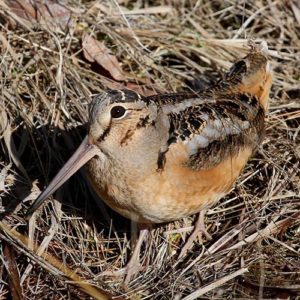
What do American woodcock look like?
The American woodcock is a little smaller than a football and their general shape kind of reminds me of a Nerf football. They spend most of their lives on the ground and are extremely well camouflaged.
Their feathers are a variety of browns, greys, tans, blacks, and buff colors that can make them seem almost invisible. They take full advantage of their “invisibility” too and will freeze when potential danger approaches. It is possible to almost step on one without seeing it until it explodes off the ground and flies away in rapid zig-zags through the trees. (Ask me how I know.)
The bill is quite long for the size of the bird – almost ¼ as long as the body. When the birds are flying and silhouetted against the late evening or early morning sky, the bill can cause the bird to look somewhat like a giant bumble bee with the stinger on the wrong end. American woodcocks also have huge black eyes that are set relatively far back on their heads.
Where can you find them?
American woodcock like areas where there is a mix of young, wet woods and nearby open areas. They are most often found in rural areas; however, they can also be found in city parks or suburbs if the right habitat is available. (The first woodcock I ever saw was next to a small drainage ditch at a city park.)
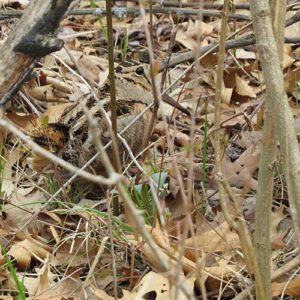
What’s a sky dance?
The sky dance is another name for the male American woodcock’s mating display. The male finds an open area near an area of young woods. Around dusk or dawn, he’ll stand in the opening and give a call that sounds like a nasally “peent.” He’ll repeat the call several times before launching into the air and flying up in long loose, spiraling circles. As he flies, the wind rushes through the feathers in his wings and across a set of specialized feathers that produces a loud, twittering whistle. He’ll then descend and start the process over again.
Basic biology and life history
Woodcocks primarily eat earthworms and other invertebrates found in the soil, which means they spend a lot of time using their bill to probe the ground for food. Their bills are pretty unique because they have a flexible tip. The tip of the upper bill can be opened to grab ahold of things even when the bill is stuck several inches into the dirt – a handy trick if your favorite food is earthworms.
Always staring at the ground could also put an animal at a huge disadvantage when it comes to avoiding predators. However, that’s where the size and location of the woodcock’s eyes comes into play. Because of the size and location of its eyes, the woodcock is able to see predators overhead even when its bill is in the ground.
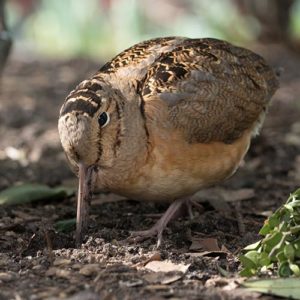
When they walk, American woodcocks have an almost comical rocking motion. It has frequently been suggested that this rocking motion was an earthworm hunting technique. However, more recent research challenges that suggestion. This is one of many areas where more research is needed on the woodcock’s life history and activities.
Male woodcocks typically begin their sky dances or mating displays in late winter and early spring. In his book, A Sand County Almanac*, Aldo Leopold writes about watching the woodcock perform the sky dance between April and June at his farm in Wisconsin. However, where I live in Kentucky, I more commonly see it from sometime in mid-February through sometime in March.
Females are attracted to the area where the male is displaying. If a female arrives during a male’s sky dance, he will land next to her and attempt to mate. Both males and females will mate with multiple individuals. Female woodcock typically lay four eggs in a shallow nest built on the ground. She is solely responsible for all of the nest building, incubation, and care of the young.
Young woodcocks grow up fast. They leave the nest with their mother only a few hours after they hatch. Within a few days, they are beginning to probe for some of their own food, although Mom will continue to feed them for a little while longer. They are completely on their own approximately a month after hatching.
Attracting and observing
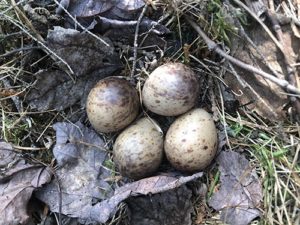
The American woodcock is one of those animals that you can’t do something simple, like putting up a feeder, to attract them. Unfortunately, if you don’t have the right habitat, then you aren’t going to attract woodcock. They really need that mixture of semi-open, young, moist woods and more open, short, grassy areas. However, you don’t have to have all of the necessary habitat on your property. You can have part of it and your neighbors can have part of it.
If you want to see American woodcock, but don’t have the right habitat in your immediate neighborhood, then you might want to check out your local city or county parks. If the park has a wet area surrounded by young trees, such as along a stream or creek, then you may be able to find woodcock there. (The short grass of soccer and other ball fields can make great staging areas for the mating displays.)
Woodcock are most active at dawn and dusk so this is the best time to watch for their sky dances. Often you will hear the displaying male before you see him. Once you hear the whistling of his wings look up to see if you can find him silhouetted against the sky. That’s the way I find them most often.
Summary
American woodcock are fascinating and unique birds that are so much fun to watch. If you have the right habitat nearby, I encourage you to go out on a warm evening or early one warm morning in late winter or early spring and try to find a displaying woodcock. You might end up with a new favorite sign of spring as you watch your first sky dance.
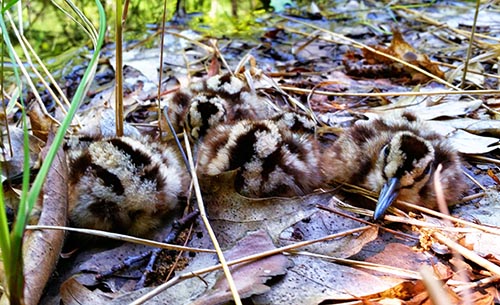

Backyard Ecology: Exploring Nature in Your Backyard
Nature isn’t just “out there.” It’s all around us, including right outside our doors. Hi, my name is Shannon Trimboli, and I am the host of Backyard Ecology. I live in southcentral Kentucky and am a wildlife biologist, educator, author, beekeeper, and owner of a nursery specializing in plants for pollinators and wildlife conservation. I invite you to join me as we ignite our curiosity and natural wonder, explore our yards and communities, and improve our local pollinator and wildlife habitat. Learn more or subscribe to my email list at www.backyardecology.net.
* Amazon links are affiliate links and I earn a small commission from qualifying Amazon purchases made the link. The commission is paid by Amazon and comes at no extra cost to you, but helps support the costs associated with hosting the Backyard Ecology blog, podcast, and website.

Leave a Reply